
Brake pads are one of the most critical components of your vehicle’s braking system. Ensuring they are properly maintained is essential for your safety on the road. In this guide, we’ll break down everything you need to know about Brake Pad Maintenance in simple terms.
Understanding Brake Pads: What Are They and How Do They Work?
Brake pads are the friction materials that press against the brake rotors to slow down or stop your vehicle. When you step on the brake pedal, hydraulic pressure forces the brake pads against the rotors, creating friction and slowing down the wheels.
Types of Brake Pads
- Semi-Metallic: Made from a combination of metal and other materials, these pads offer excellent performance and durability.
- Ceramic: Known for their quieter operation and cleaner wheels, ceramic brake pads are ideal for everyday driving.
- Organic: Made from natural materials like rubber, glass, and Kevlar, organic brake pads are budget-friendly but less durable than other types.
Signs That Your Brake Pads Need Attention
Regular inspection of your brake pads is essential to ensure they’re in good condition. Here are some signs that indicate your brake pads may need maintenance:
- Squealing or Grinding Noises: A high-pitched squeal or grinding sound when braking could mean your brake pads are worn out.
- Reduced Braking Performance: If it takes longer to stop or you notice a mushy brake pedal, it’s time to check your brake pads.
- Visual Inspection: You can visually inspect your brake pads through the wheel spokes. If they appear thin (less than 1/4 inch), it’s time for replacement.
DIY Brake Pad Inspection and Maintenance

Checking your brake pads regularly can help prevent more extensive damage to your braking system. Here’s a simple step-by-step guide:
Tools You’ll Need
- Jack
- Lug wrench
- Flashlight
- Brake pad gauge (optional)
Steps to Inspect Your Brake Pads
- Park on a Level Surface: Ensure your car is parked on a flat surface and engage the parking brake.
- Loosen the Lug Nuts: Loosen the lug nuts on the wheels you want to inspect but don’t remove them completely.
- Jack Up the Vehicle: Use a jack to lift the vehicle off the ground, then remove the lug nuts and the wheel.
- Inspect the Brake Pads: Shine a flashlight through the wheel spokes to inspect the brake pads. Look for signs of wear or damage.
- Measure the Brake Pad Thickness: If you have a brake pad gauge, use it to measure the thickness of the brake pads. Compare the measurement to the manufacturer’s specifications.
Maintenance Tips
- Clean the Brake Components: Use a wire brush to remove any debris or rust from the brake calipers and pads.
- Apply Brake Lubricant: Apply a thin layer of brake lubricant to the back of the brake pads to prevent squeaking and ensure smooth operation.
- Check Brake Fluid Level: While you’re inspecting the brake pads, take the opportunity to check the brake fluid level in the reservoir. Top it up if necessary.
When to Replace Your Brake Pads
Knowing when to replace your brake pads is crucial for your safety. While the lifespan of brake pads can vary depending on driving habits and conditions, a general rule is to replace them every 30,000 to 70,000 miles.
Signs It’s Time for Replacement
- Thin Brake Pads: If the brake pads are worn down to 1/8 inch or less, they need to be replaced.
- Brake Warning Light: Some vehicles have a brake warning light that illuminates when the brake pads are worn out.
- Uneven Wear: Uneven wear patterns on the brake pads indicate a problem with the braking system that needs to be addressed.
Professional Brake Pad Replacement
While inspecting and maintaining your brake pads yourself is possible, some tasks are best left to the professionals. If you’re not confident in your abilities or if you notice any signs of brake pad wear, it’s best to take your vehicle to a qualified mechanic for inspection and replacement.
Conclusion
Brake pad maintenance is a vital aspect of vehicle ownership that should not be overlooked. By understanding how your brake pads work, knowing when to inspect them, and taking proactive maintenance measures, you can ensure that your vehicle’s braking system remains in top condition, keeping you safe on the road for miles to come.
Note:-For more articles, visit on incnewsblogs.







